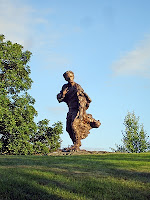Towards the end of June, I returned to my alma mater, Brandeis University. It could not be more different from Duke University if it tried. Brandeis, founded in 1948 by Justice Louis D. Brandeis, is among the country’s youngest universities. Therefore, it should come as no surprise that its architecture is a reflection of its times. The campus today, however, hardly resembles the Brandeis from the 50s. It has truly morphed from a grid of homogenized, brick, low-rise structures to a Mecca of architectural bravura. As I mentioned in my discussion of Duke, the Brandeis campus faced a similar conundrum upon its recent renovations. It took a bold approach to change in erecting new facilities in a completely avant-garde style. No conscious effort was made to blend these new buildings into their existing surroundings, but rather, they are purposefully bold and use cutting edge materials. One such example is called the Shapiro Campus Center, known by students as “The Big Green Monster.” When it opened in 2004, it caused a fairly pervasive uproar. Everyone you asked had an opinion, and it was usually negative. People hated the color (patinated copper), the scale, and the fact that it didn’t blend in. But it shortly became the nucleus of the campus, and steadily thereafter more buildings in a similarly contemporary style began to emerge throughout the university (dormitories, academic buildings, the admissions center, etc.). Immediately upon my return I toured the new science complex. It is a true architectural marvel situated on the highest point of campus, which lends for incredible views of the sports fields in the foreground and the city of Boston in the backdrop. It links to the existing complex, but a clear line has been drawn between old versus new (this clearly reads as intentional). Many features of the campus remain the same, such as student dormitories, the Rose Art Museum, classroom buildings, and chapels, but it is overtly obvious that Brandeis has entered into the 21st century, and its brave and striking architectural commissions helped lead the way.
Images: Statue of Louis D. Brandeis, the Rose Art Museum, Shapiro Campus Center, The Village Dormitory, two views of the new Science Complex







No comments:
Post a Comment